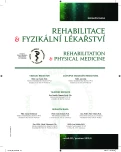Trunk and Cervica Muscles Activity during Straightening of Cervicothoracic Spine Segment Provoked by External Rotation of the Arm
Authors:
I. Jelínková; M. Šorfová
Authors‘ workplace:
Katedra fyzioterapie FTVS UK, Praha
vedoucí katedry doc. PaedDr. D. Pavlů, CSc.
; Katedra anatomie a biomechaniky FTVS UK, Praha
vedoucí katedry doc. PaedDr. K. Jelen, CSc.
Published in:
Rehabil. fyz. Lék., 20, 2013, No. 4, pp. 215-220.
Category:
Original Papers
Overview
A relaxed standing is natural, but it leads to a back pain. Erect posture was provoked by an external humeral rotation and adduction of the shoulder that resulted in increased activation of the trunk muscles. The stabilized trunk led to the upright posture of the cervical-thoracic spine. The kinematics of the spine and the inclination of the pelvis were measured in the sagittal plane with a motion analysis system. The trunk and neck muscle activity was measured with the electromyography. Six subjects without pathology of the pelvis, shoulder girdle and spine were recruited in this pilot study. The possible correlation between the postural changes and the changes of the muscle activity was determined: the tilt of the pelvis could correlated with the internal oblique, quadratus lumborum and external oblique posterior part, the change of the shape of the cervical-thoracic spine could related with the erector spinae in the thoracic region.
Keywords:
relaxed posture, upright posture, cervico-thoracic spine, muscle coactivation, paravertebral muscles, m. latissimus dorsi
Sources
1. BONNEY, R. A., CORLETT, N.: Head posture and loading of the cervical spine. Appl. Ergon., 33, 2002, s. 415-417.
2. BULLOCK-SAXTON, J.: Normal and abnormal postures in the sagittal plane and their relationship to low back pain. Physiother. Pract., 4, 1988, s. 94-104.
3. CANEIRO, J. P. et al.: The influnce of different sitting postures on head/neck posture and muscle activity. Manual Ther., 2010, 15, s. 54-60.
4. CORREA, E., BERZIN, F.: Efficacy of physical therapy on cervical muscle activity and on body posture in school-age mouth breathing children. Int. J. Pediatr. Otorhi., 2007, 7, s. 1527-1535.
5. CRAM, R. J.: Cram's introduction to surface electromyography. Canada, Jones & Bartlett Learning, 2010, s. 412.
6. DOLAN, P., ADAMS, M. A.: The relationship between EMG aktivity and extensor moment generation in the erector spinae muscles during bending and lifting activities. J. Biomech., 1993, 26, s. 513-522.
7. GRANATA, K. P., ORISHIMO, K. F.: Response of trunk muscle coactivation to changes in spinal stability. J. Biomech., 34, 2001, s. 1117-1123.
8. HARRISON, D. E.: Concurent validity of flexicurve instrument. Measurements: Sagittal skin contour of the cervical spine compared with lateral cervical radiographic mesurements. J. Manipulative Physiol. Ther., 2005, 8, s. 597-603.
9. KENDALL, F. P.: Muscles: testing and fuction with posture and pain. Philadelphia, Williams and Wilkins, 2010, s. 482.
10. KOLÁŘ, P., LEWIT, K.: Význam hlubokého stabilizačního systému v rámci vertebrogenních obtíží. Neurol. Prax., 2005, č. 5, s. 258-262.
11. LAU, K. T. et al.: Relation between sagittal postures of thoracic and cervical spine, presence of neck pain, neck pain severity and disability. Manual Ther., 2010, 15, s. 457-462.
12. MCAVINEY, J. et al.: Determination the relationship between cervical lodosis and neck complaints. J. Manip. Physiol. Ther., 3, 2005, 28, s. 187-193.
13. MORL, F., BRADL, I.: Lumbar posture and muscular activity while sitting during office work. J. Electromyogr. Kines., 2012, 12, s. 1-6.
14. MORRIS, C. E. et al.: Vladimir Janda, MD, DrSc; tribute to a master of rehabilitation. Spine, 31, 2006, s. 1060-1064.
15. NG, J. K. F., KIPPERS, V., RICHARDSON, C. A.: Muscle fibre orientation of abdominal muscles and suggested surface EMG electrode positions. J. Electromyogr. Clin. Neurophys., 38, 1998, s. 51-58.
16. O'SULLIVAN, P. et al.: The effect of different standing and sitting postures on trunk muscle activity in a pain-free population. Spine, 2002, 11, s. 1238-1244.
17. PEARSALL, D. J., REID P. M.: Line of gravity relative to upright vertebral posture. J. Clin. Biomech., 1992, 7, s. 80-86.
18. SEZE, P. M.; CAYALATS, J. R.: Anatomical optimalization of skin electrode placement to record elektromyographic activity of erector spinae muscles. Surg. Radiol. Anat., 30, 2008, s. 137-143.
19. SMÍŠEK, R., SMÍŠKOVÁ, K., SMÍŠKOVÁ, Z.: Spirální stabilizace: léčba a prevence bolestí zad. Praha: Smíšek R., 2011. s. 149.
Labels
Physiotherapist, university degree Rehabilitation Sports medicineArticle was published in
Rehabilitation & Physical Medicine

2013 Issue 4
- Hope Awakens with Early Diagnosis of Parkinson's Disease Based on Skin Odor
- Deep stimulation of the globus pallidus improved clinical symptoms in a patient with refractory parkinsonism and genetic mutation
Most read in this issue
- Combined Training of Closed and Open Kinematic Chains in Rehabilitation Exemplified by the FLOWIN® System
- Osteochondral Articular Junction and Osteoarthrosis
- The Observation of the Dynamics of a Clinical Picture in a Chronic Cervicobrachial Syndrome with the Aid of the Principles of McKenzie Concept
- The Inclination and Shape Modulation of Cervicothoracic Connection of Spine Provoked by External Rotation of the Arm
